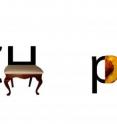Design vs. dyslexia: UC innovation promises new hope for children with dyslexia
Reading and retaining information. That's the challenge faced by the one in five children who have some form of dyslexia. Overcoming that challenge could soon become easier for educators and children thanks to pioneering design research from the University of Cincinnati's internationally ranked College of Design, Architecture, Art, and Planning (DAAP).
Renee Seward, UC assistant professor of digital design, will present her innovative electronic project, titled "Reading by Design: Visualizing Phonemic Sound for Dyslexic Readers 9-11 Years Old," at the Southwest International Reading Association Regional Conference in Oklahoma City, Okla., on Feb. 5, 2010.
She will likewise present her research project during the March 2010 International Technology, Education and Development Conference in Valencia, Spain. (In Spain, Seward is scheduled to be a virtual presenter.)
In developing this toolkit to help educators more effectively assist children with dyslexia, Seward has developed an online tool that creatively employs sight, sound and physical movement to increase the reading and retention abilities of children aged 9 to 11 who have dyslexia. (A separate portion of the project employs physical tools and employs touch to aid educators and children.)
The project was inspired by the struggles of a friend's child to read.
HOW "READING BY DESIGN" WORKS
"In my work," said Seward, "I want to deemphasize the 26 letters of the alphabet and emphasize the 44 common sounds of the English language. I do so by helping educators employ children's senses, from the visual to the kinesthetic."
The key, she added, is knowing that dyslexia is not rooted in problems with visual perception. It's rooted in memory. Individuals with dyslexia have difficulty recalling and making a quick connection between a sound and the letter representing that sound.
"The child is able to read the letter 'b.' He or she is unable to quickly recall that we associate that symbol with the sound, 'buh.' That's dyslexia in a nutshell."
So, in the toolkit she is developing, Seward begins with the smallest units of sound and helps children associate them with letter forms. With the touch of a mouse, a teacher working with a child can scroll over the letter "p," and the "p" will then morph to display common items associated with the "puh" sound: (peach, peppermint, pie, pea and piano).
The "Reading by Design" toolkit has a number of other activities:
- Sound elements and creative visuals working in concert to reinforce reading retention and recall (SEE VIDEO).
- Common sounds – like the "ooohing" of a crowd following a great basketball play (along with the visual of a basketball player making that play) – depict and reinforce the connections between visual vowel combinations like "oo" and "ew" and their appropriate phonemic sound.
- Horizontal lengthening of words with long vowels to denote that vowel and the silent "e" (in words like "note"). The child can experience the lengthening word with a sweep of the mouse to the right, thus integrating movement into memory. (SEE VIDEO).
- Also, when moving the mouse over long vowels, the cursor will not move up or down, only in a horizontal lengthening of the vowel to the right – in order to visualize the phonemic value of that vowel. Again, the rightward sweep of the mouse also incorporates the child's arm movement into memory formation and retention.
- Silent letters appropriately take on a shadow form or repel the mouse.
- A cursor that moves just like a finger following the text (common to how most children read during their early years).
TESTING THE TOOLKIT
Seward likens her project to a parent holding a child's bike as the child learns to ride. Little by little, the parent is able to forego providing complete support and moves to an occasional steadying hand until, ultimately, the child is riding under his or her own power.
She explained, "This electronic toolkit is a scaffold that can be built upon and then taken away."
Source: University of Cincinnati
Other sources
- Design vs. Dyslexia: Innovation promises new hope for children with dyslexiafrom Science DailyWed, 27 Jan 2010, 18:28:36 UTC
- Design vs. dyslexia: UC innovation promises new hope for children with dyslexia (w/ Video)from PhysorgTue, 26 Jan 2010, 19:21:35 UTC
- Design vs. dyslexia: UC innovation promises new hope for children with dyslexiafrom Science BlogTue, 26 Jan 2010, 19:14:35 UTC

